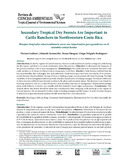Mostrar el registro sencillo del ítem
Secondary Tropical Dry Forests Are Important to Cattle Ranchers in Northwestern Costa Rica
| dc.contributor.author | Godinot, Florent | |
| dc.contributor.author | Somarriba, Eduardo | |
| dc.contributor.author | Finegan, Bryan | |
| dc.contributor.author | Delgado-Rodríguez, Diego | |
| dc.date.accessioned | 2020-07-30T17:11:21Z | |
| dc.date.available | 2020-07-30T17:11:21Z | |
| dc.date.issued | 2020-07 | |
| dc.identifier.issn | e-ISSN: 2215-3896 | es_ES |
| dc.identifier.uri | https://repositorio.catie.ac.cr/handle/11554/9475 | |
| dc.description.abstract | In the dry regions of Central America, forests in cattle ranches are used as a refuge for cattle during the dry season, and there is no much information about this practice. To determine the frequency of this practice and how it fits in farm management. We conducted semi-structured interviews with cattle ranchers in 43 farms in Liberia County, Guanacaste, Costa Rica. Cattle farmers suffered from the loss of profitability due to droughts, fire, and cattle theft. Cattle browsing in the forest was used by 70 % of farms, mostly between March and May. No type of farm or feeding strategy was associated with forest browsing. The high variability in farm management did not provide a distinct classification of feeding strategies. We found a difference in farm structure and feed types between ranches in the plains and mountain slopes. The decision to use forests for browsing seemed to rely on a trade-off between animal welfare and ease of management. Traditional knowledge about cattle behavior in forests was variable and often limited to forest edges and pastures. This research shows that forests should be taken into consideration when analyzing cattle ranching in dry regions of Central America. We recommend a further study on feeding strategies and the impact of cattle on forest integrity to determine if agricultural policymakers should foster these low-costs alternatives. | es_ES |
| dc.language.iso | en | es_ES |
| dc.relation.ispartof | Revista de Ciencias Ambientales, 54(2): p.20-50 | es_ES |
| dc.rights | info:eu-repo/semantics/openAccess | es_ES |
| dc.subject | BOSQUE SECUNDARIO | es_ES |
| dc.subject | BOSQUE TROPICAL | es_ES |
| dc.subject | CORREDOR SECO MESOAMERICANO | es_ES |
| dc.subject | EXPLOTACIONES GANADERAS | es_ES |
| dc.subject | RAMONEO | es_ES |
| dc.subject | ESTACION SECA | es_ES |
| dc.subject | MANEJO DE FINCAS | es_ES |
| dc.subject | ADAPTACION | es_ES |
| dc.subject | ECOSISTEMA | es_ES |
| dc.subject | COSTOS DE PRODUCCION | es_ES |
| dc.subject | LIBERIA | es_ES |
| dc.subject | GUANACASTE | es_ES |
| dc.subject | COSTA RICA | es_ES |
| dc.subject | MANEJO DEL GANADO | es_ES |
| dc.title | Secondary Tropical Dry Forests Are Important to Cattle Ranchers in Northwestern Costa Rica | es_ES |
| dc.title.alternative | Bosques tropicales estacionalmente secos son importantes para ganaderos en el noroeste costarricense | es_ES |
| dc.type | Artículo | es_ES |


